Liberia part II
The first motorcycle on the first block is a Belgian FN.
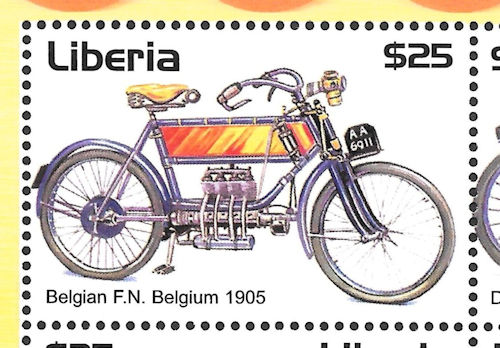
FN, or in full Fabrique National, had been established in Liege as part of FN d'Armes de Guerre from Herstal, an arms producer since 1899, to get some diversity in the activities of FN. After having developed the concept of a motorcycle in 1904, FN entered the market with its first product in 1905, a 350cc motorcycle with no gears. For idling/standstill the transmission had to be interrupted by means of a cable. Not before 1907 a 2-speed gearbox that had to be separately installed was offered as option. Originally the first FN's were delivered without acetylene lamp and with a constant spark generator for the ignition. The model depicted here is exhibited in the Science Museum, South Kensington in London.
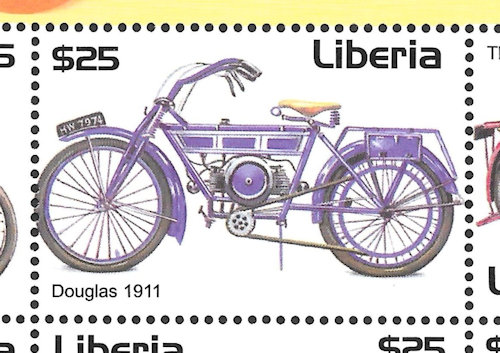
The Douglas Engineering Company was established by the brothers William and Edwin Douglas. They started their smithy in Bristol in 1882. There they made parts for the motorcycle factory of Joseph L. Barter, who built clip-on engines under the name Fée (later Fairy). When this enterprise became bankrupt in 1906, Barter joined the Douglas brothers' company and in 1907 they started a small factory for motorcycles under their name. In 1907 24 of the 27 motorcycles built were sold. In 1910 they scored a success by winning the Scottish Six Days Trial, partly by applying a 2-speed gear box developed by Barter, a novelty at that time. Under the engine was a small box with the gear mechanism of a lathe, operated by a turning handle on the fuel tank. Because this turning handle resembled the speed controller of a tram, this model got the nickname "Tram Driver".
It was already known that the stamp designer got its inspiration from the internet, but on this image of the model D from 1911 he has left out the
lantarn, bicycle pedals and chain that are found on the original.
In the upper right of block 1 a Scott motorcycle from 1914.
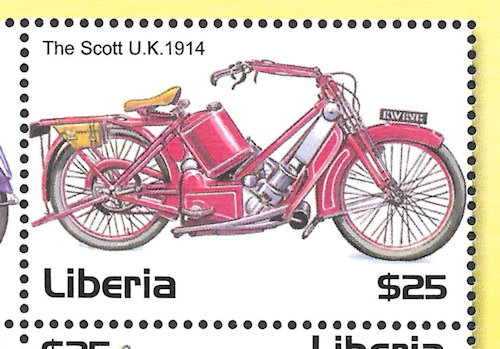
In newsletters 32 (June 1995) and 100 (June 2012) respectively Jan T. and Paul E. have widely spoken about this brand, and therefore I want to restrict myself here to a few trivia. The 532cc sized 2-cilinder engine was used in the 1914 model: the Standard. The development of further models stand still during the First World War in 1914-1918 due to production orders from the army. After the war the civil branch was restarted with the Standard and Standard Touring model.
In 1922 Scott presented its Squirrel model and the Flying Squirrel, each with a 486cc engine. The Squirrel had drip lubrication
from a small tank that was mounted on the frame between the legs, the Flying Squirrel had a bigger fuel tank and 2 spark plugs per cylinder. The standard did not have these provisions but had already footboards and a heel-and-toe pedal for the 2-speed gearbox.
On the stamp a motorcycle completely in red with bare cylinders, but in reality the early models had a black frame, a fuel tank in colour and
always dark red cylinders.
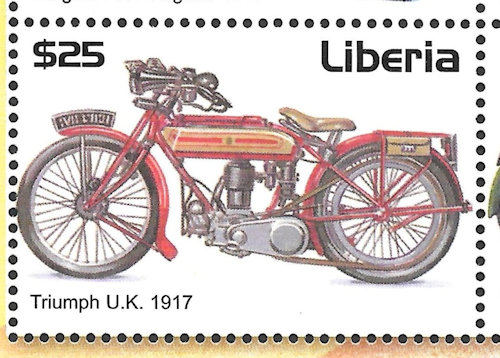
In fact we have to pronounce Triumph the German way. This is the story: German Siegfried Bettman emigrated in 1885 from Neurenberg to England. One year later he started a small bicycle shop in London. First under the name Bettmann & Co., but soon he changed the name into Triumph Cycle Company and within another year in New Triumph Co. Ltd. Now he also began to sell sowing machines from Germany. In 1888 he bought a factory in Coventry, together with a partner, and in 1889 the first Triumph bicycle was produced there. In 1896 Triumph also opened a factory for the production of bicycles in Neurenberg. To avoid confusion, the motorcycles built in Germany were first sold under the name Orial. But because there was already a French brand with the same name, the name was changed into TWN, Triumph Werke Neurenberg.
In England the Triumph factory was housed in the already existing Gloria factory. In 1913 the Model C was introduced. This motorcycle had a 3-speed hub gear
and a 500cc engine. At the beginning of the First World War the English army was looking for a reliable replacement for the horses and came to Triumph. The C model was equipped with a gearbox operated with a lever and the cylinder volume was increased to 550cc. In 1917 the Triumph Model C was renamed into Model H, which was popularly called Triumph Trusty. Production stopped in 1923 after 57.000 units of Model H had been made.
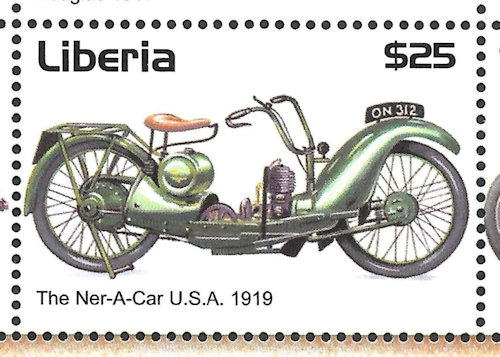
The Ner-A-Car motorcycle from 1925 tried to apply the advantages of a car on a motorcycle. The designer, Carl Neracher, designed and built his first motorcycle in 1918.
The name of the motorcycle is a pun
on the name Neracher and immediately represents the intentions of the maker, Ner-A-Car (almost a car). Therefore the slogan was "An automobile on 2 wheels!". The model was known for its stability, amongst others by the use of hub centered steering, and better protection than the "normal" motorcycle of these days could offer. Yearly around 1500 units of the motorcycle were built in Syracuse, New York state, in the period 1921 (1000 units) until 1926. Next to that also in England a number has been built under license by Simplex in Sheffield.
The last stamp from the first block shows a Moto Guzzi from the year 1950.
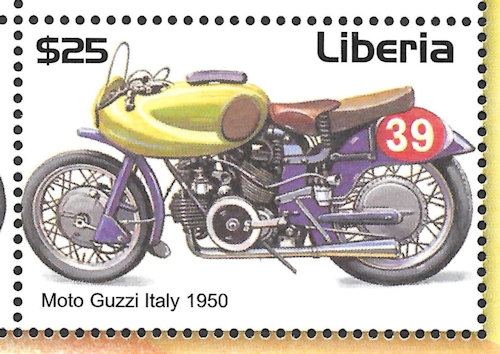
But I could not find this exact model, and think it is a free interpretation by the stamp designer of the Guzzi V2 Bicilindrica 500:
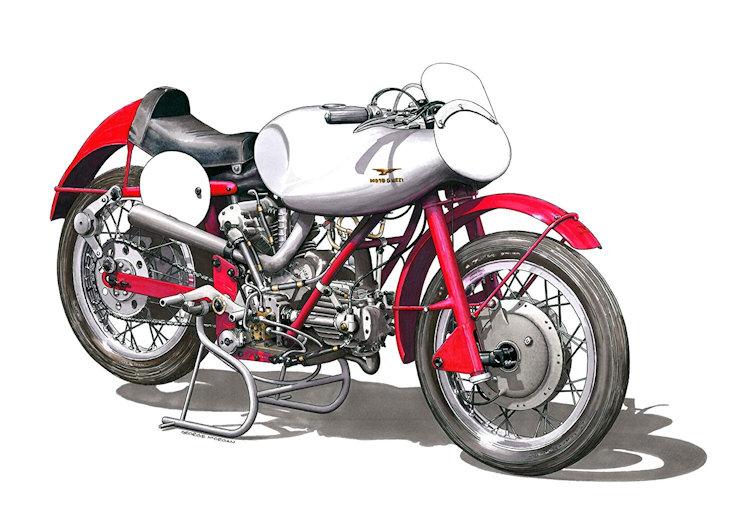
In the early years Moto Guzzi addressed itself in the racing sports mainly to the 250cc class. They scored very well with a single cylinder engine as power source. In 1934 the heavier class became of more interest for the public sales and forced by the power increase of (English) competitor bikes by using multi cylinder engines, Carlo Guzzi also had to come with a new design. He choose for the unsurpassed 250cc engine and placed a second cylinder on it under an angle of 120° by which, together with a few other modifications, an engine with a cubic capcity of 494cc was obtained. The 2-cylinder overhead valve engine had bevel-driven camshafts and because of the transverse engine position the 2 cylinders had a different direction of the cooling fins, which gave a strange look. The contents of the fuel tank were enlarged by making the tank around the headstock, but this resulted in a non-optimal steering on curvy circuits. On the Isle of Man TT-circuit this was not a problem and Stanley Woods celebrated several successes on the Mountain circuit with the Guzzi Bicilindrica 500 V2.
In the lower part of the block again the image of the earlier discussed Zenith with Gradua variable belt drive.
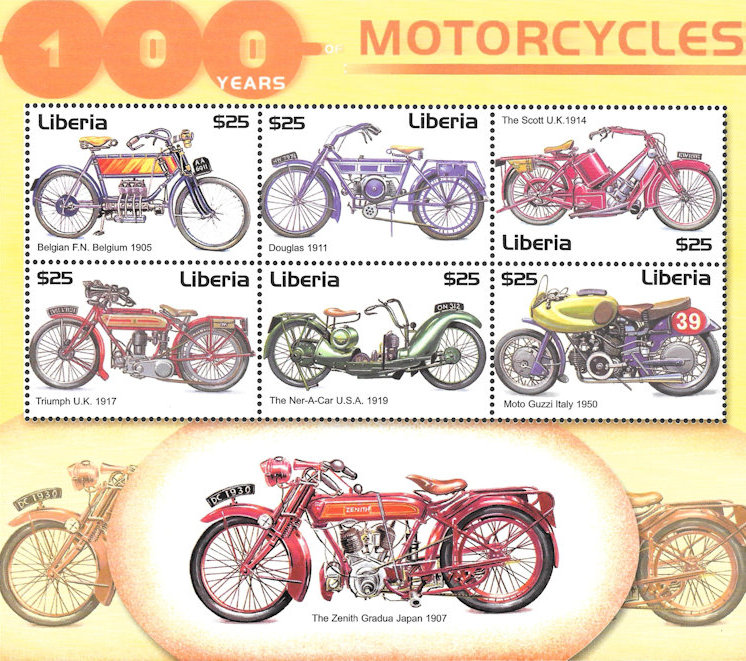
From several persons I got questions about it, and especially about the "sliding rear wheel". So despite the fact that we are a stamp club, I want to give a short explanation about this. First about the transmission. With a turning handle placed on top of the fuel tank, the rider could make the vertically split front pully which drives the belt wider or narrower. The sides of this pully had been made a bit tapered. When the front pully is made narrower, the effective diameter for the belt will grow, and the transported belt length per revolution will increase, resulting in a higher belt speed. At the same time the rear pully must make some room to give the belt space and length. Because its effective diameter will thus shrink, the rear wheel will rotate faster. Thus with 1 action a twofold stepless gear change.
Below the front pully and right next to it the rear pully. In the right image the belt is drawn in both the lower (fast) and higher (slow) position. The outer side of the pully thus moves outwards and inwards relative to the wheel
by a rod meachnism connected to the handle.
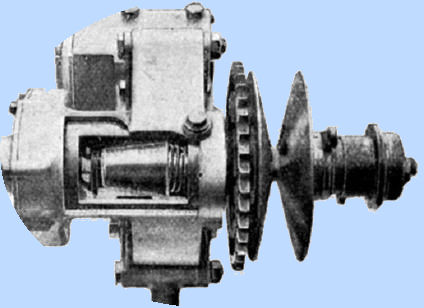 |
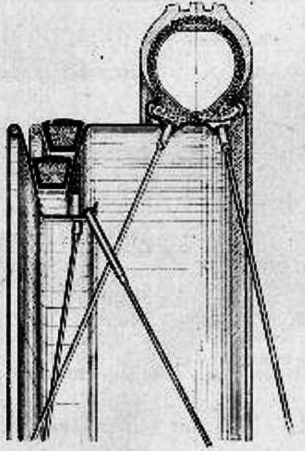 |
Because this system had some free play, the belt had to be tensioned regularly. Zenith engineer Barnes had invented rear forks with built-in tensioning springs that kept the belt at the right tension by sliding the rear wheel forwards and backwards.
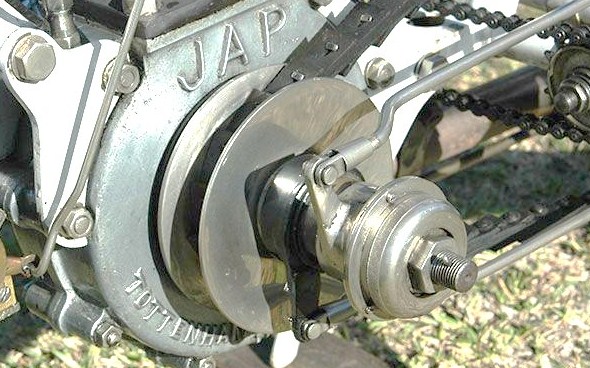

The same system was also applied by Hub van Doorne (DAF) in his DAF 600 (and was then called Variomatic system) and later used by eastern manufacturers in cars, scooters and motorcycles under the name CVT (Continuous Variable Transmission), but let us stick to the Gradua System invented by Barnes.
Next time we will discuss the last block.
Hans de Kloet
Top - Back to former page - Home |











